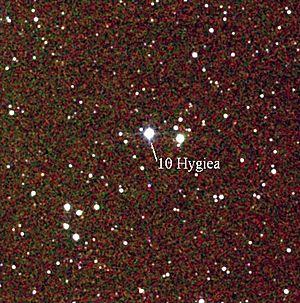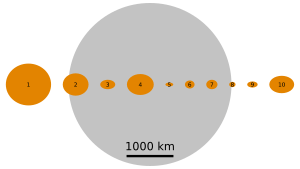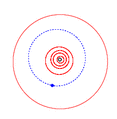10 Hygiea facts for kids

Hygiea by 2MASS
|
|
| Discovery | |
|---|---|
| Discovered by | A. de Gasparis |
| Discovery date | April 12, 1849 |
| Designations | |
| none | |
| Main belt (Hygiea family) | |
| Orbital characteristics | |
| Epoch July 14, 2004 (JD 2453200.5) | |
| Aphelion | 525.311 Gm (3.511 AU) |
| Perihelion | 413.378 Gm (2.763 AU) |
| 469.345 Gm (3.137 AU) | |
| Eccentricity | 0.119 |
| 2029.776 d (5.56 a) | |
|
Average orbital speed
|
16.76 km/s |
| 273.788° | |
| Inclination | 3.842° |
| 283.646° | |
| 313.557° | |
| Physical characteristics | |
| Dimensions | 500×385×350 km |
| Mass | 8.6 ± 0.7 ×1019 kg |
|
Mean density
|
2.4 g/cm³ |
| 0.091 m/s² | |
| 0.21 km/s | |
| 1.1510 d | |
| Albedo | 0.072 (geometric) |
| Temperature | ~164 K max: 247K (−26° C) |
|
Spectral type
|
C-type asteroid |
| 9.1 to 11.97 | |
| 5.43 | |
| 0.318" to 0.133" | |
10 Hygiea is the fourth biggest object in the asteroid belt. It is somewhat non-spherical in shape, with diameters of 350 – 500 km. Its mass is estimated to be 3% of the total mass of the asteroid belt.
It is the biggest of the class of dark C-type asteroids with a carbonaceous surface that are dominant in the farther part main belt, which lies beyond the Kirkwood gap at 2.82 AU, and is also the biggest body in this region. Its dark surface and bigger than average distance from the Sun makes it very dim for such a big asteroid when seen from Earth. In fact it is the third dimmest of the first twenty-three asteroids discovered, with only 13 Egeria and the quite small 17 Thetis having lower mean opposition magnitudes.
At most oppositions, Hygiea has a magnitude of around +10.2, which is as much as four orders fainter than Vesta, and will need at least a 4-inch telescope to resolve. At a perihelic opposition, however, Hygiea can reach +9.1 and may just be resolvable with 10x50 binoculars, unlike the fifth and sixth biggest asteroids 704 Interamnia and 511 Davida which are always beyond binocular visibility.
Contents
Discovery
Hygiea was found by Annibale de Gasparis on April 12, 1849 in Naples, Italy. It was the first of his nine asteroid discoveries. It is named after Hygieia, the Greek goddess of health, daughter of Asclepius (Aesculapius for the Romans).
The asteroid was named by the director of the Naples observatory, Ernesto Capocci. He called it Igea Borbonica ("Bourbon Hygieia") in honor of the ruling family of the Kingdom of the Two Sicilies where Naples was located. However, by 1852, John Russell Hind wrote that "it is universally termed Hygeia, the unnecessary appendage 'Borbonica' being dropped."
The name was often spelled Hygeia in the nineteenth century, for example in the Monthly Notices of the Royal Astronomical Society.
Characteristics

Hygiea's surface is made of primitive carbonaceous material similar to the chondrite meteorites. It is the main member of the Hygiea family and contains almost all the mass in this family (well over 90%).
Generally Hygiea's properties are the least known out of the "big four" objects in the main belt. Its orbit is much closer to the plane of the ecliptic than those of Ceres, Pallas or Interamnia, but is less circular than Ceres or Vesta with an eccentricity of around 12%. Its perihelion is at a quite similar longitude to those of Vesta and Ceres, though its ascending and descending nodes are opposite the corresponding ones for those objects. Although its perihelion is extremely close to the mean distance of Ceres and Pallas, a collision between Hygiea and its bigger companions is impossible because at that distance they are always on opposite sides of the ecliptic. At aphelion Hygiea reaches out to the extreme edge of the asteroid belt at the perihelia of the Hilda family which is in 3:2 resonance with Jupiter.
It spins unusually slow, taking 27 hours and 37 minutes to complete one rotation, whereas 6 to 12 hours are more typical for big asteroids.
At least 5 stellar occultations by Hygiea were tracked by Earth-based observers, but all with few seeing independent measurements so that much was not learned of its shape. The Hubble Space Telescope was able to resolve the asteroid, and to rule out the presence of any orbiting companions bigger than about 16 km in diameter
— Horizons can be used to obtain a current ephemeris.
Images for kids
See also
 In Spanish: (10) Hygiea para niños
In Spanish: (10) Hygiea para niños







